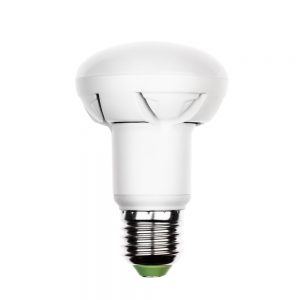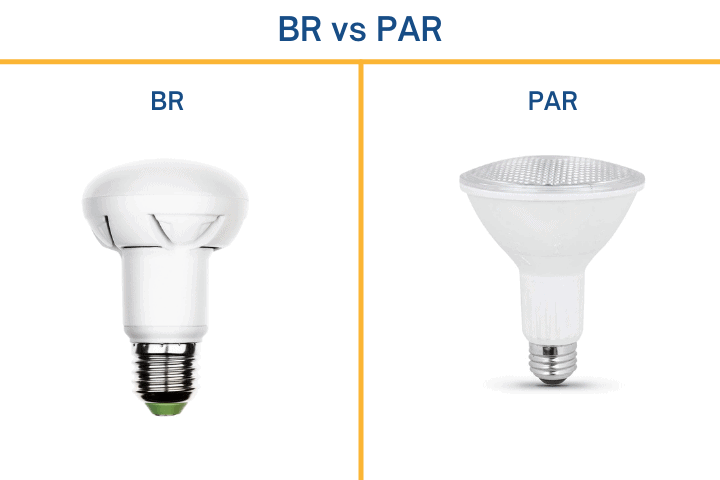If you’ve ever researched into switching the lights in your home to LEDs, the chances are you’ll have come across PAR30 bulbs already. Favored for their versatility, PAR30 bulbs are often the directional lighting of choice for indoor and outdoor contexts.
Unlike other types of bulb, when choosing a PAR30, you’ll have to decide between a long neck or a short neck. But this tends to throw people off.
What is meant by neck length, and when should you use a long neck or short neck PAR30 bulbs?
Long neck PAR30s are bigger and have more space between the head of the bulb and the screw. Short neck PAR30s, whereas, are smaller in height and contain less space in their base. BR30 bulbs have an extra bulged neck to utilize the best luminosity of the bulb.
Still confused? Do not fret!
In this blog post, I’m going to walk you through everything PAR30, including the difference between short necks and long necks, when you should use them, and how PAR30s compare to BR30s.
What are PAR30 bulbs?
First off, let’s look at why PAR30s are so special. PAR stands for a parabolic aluminized reflector. In this context, ‘parabolic’ means that the light uses symmetrical U-shaped reflector, and ‘aluminized’ means it’s coated with aluminum.
The number 30 refers to the diameter of the bulb. PAR bulbs are typically available in 5 sizes: 16, 20, 30, 36, and 38. But I’ll come back to this later.
To put it simply, a PAR is a self-contained light bulb consisting of a lamp, parabolic reflector, and lens.
PARs are a concentrated source of light, as their light can be easily controlled and directed into designated spaces. In fact, PAR LEDs can produce up to four times the amount of concentrated light than equivalent incandescent and halogen bulbs!
On top of this, PAR bulbs are available in a variety of beam angles:
| Name | Beam Angle |
|---|---|
| Narrow Spotlight | 5° – 15° |
| Spotlight | 16° – 22° |
| Narrow Floodlight | 23° – 32° |
| Floodlight | 33° – 45° |
| Wide Floodlight | Over 45° |
PAR30 Short Neck Bulbs
The unusual thing about PAR30s, compared to the other PAR diameters, is they’re available with short necks or long necks.
As the name suggests, short neck PAR30s are smaller and will sit further back in recessed canister fittings than long neck bulbs. For this reason, they’re particularly advantageous in confined and narrow spaces.
One demonstration of this is shallow ceilings, where there is not a lot of clearing space for recessed lights. Beyond this, PAR30 bulbs are commonly used in track fixtures, smaller recessed canisters, and underwater wells.
Both short neck and long neck PAR30 bulbs contain the same wattage, but in recessed canister lights, short necks will have narrower, more concentrated beams. This is because they sit further back in the fitting, which means light is restricted by the edges of the fixture.
Long Neck Bulbs
Long neck bulbs, whereas, are bigger and longer than their short neck counterparts. They take up more space, which means in canister fittings, they will either sit flush or protrude outwards.
As long necks are not restricted by the edges of canister fittings, their beams of light are wider. This means long neck PAR30s are ideal for outdoor lighting, spotlights, projectors, landscape lighting, bigger canister fittings, and lampposts.
What Are The Dimensional Differences?
As I mentioned earlier, the number ‘30’ in PAR30 refers to the diameter of the bulb. This is represented as 1/8th of an inch or 0.125. The diameter of a bulb can, therefore, be calculated by multiplying the PAR number by 0.125.
So the diameter of a PAR30 bulb is 3.75 inches. This number remains the same for all PAR30 bulbs, regardless of whether they’re short or long-necked.
Short and long necks do differ, however, in their lengths. Exactly how long is a PAR30 long neck bulb?
To work this out, I looked at the top ten bulbs for short neck and long neck PAR30. The length of long neck bulbs ranged from 4.2 to 5 inches. On average, this works out at 4.74 inches.
On the flip side, short neck bulbs ranged in length from 3.4 to 4.72 inches. As an average figure, this is 3.978 inches.
So the dimensional differences of short neck and long neck PAR30s range from bulb to bulb. Typically, however, long neck bulbs are around 1 inch longer.
| Type of Bulb | Average Length | Width (Diameter) |
|---|---|---|
| Short Neck PAR30 | 3.978 inches | 3.75 inches |
| Long Neck PAR30 | 4.74 inches | 3.75 inches |
What Is a Bulged Reflector (BR) Bulb?

An R bulb is a Reflector bulb, and a BR bulb is a Bulged Reflector bulb.
The BR bulb was made to replace the R and is an updated technology that is slowly becoming a more preferred bulb as the R is phased out.
You will find many more BR then R bulbs in the market.
A reflector is the painted shiny surface circumventing the inside or outside of the bulb’s body.
The role of any reflector inside a bulb is to direct the light that is radiated to the back of the bulb and reflect it out towards the lens.
The name ‘bulged’ comes from a physical feature designed to correct the inefficiency of an R bulb.
A BR bulb is shaped to have an extra bulge at the neck of the bulb to include a reflecting surface area off of which the internal light can bounce back outwards, utilizing the full luminosity of the light!
BR30 vs PAR30: What Is The Difference?

Now that I’ve established what PAR30 bulbs are, you may be wondering how they differ from BR30 bulbs. As BR30 and PAR30 bulbs share the same diameter, in most fixtures the two are interchangeable.
The real difference is the type of light they produce.
BR stands for the bulged reflector. The ‘bulged’ element comes from the neck of the bulb, which contains an extra reflector to capture light that is usually lost in other bulbs.
Unlike PAR30 bulbs, which give off concentrated, directional light, BR bulbs emit wide flood beams of light.
Although PAR30s are available as wide floodlights with beam angles above 45 degrees, this is nothing in comparison to BR bulbs.
Most BR bulbs have a beam angle of 120 degrees. This means they’re perfect for illuminating large areas, such as auditoriums and sports pitches.
Furthermore, BR bulbs also feature a frosted or patterned coating. This means they deliver a soft, diffused light that has a wall washing effect on large areas.
Instead of the harsh, focused light provided by PARs, BR bulbs give off an overall glow that contains no shadows. But the upshot of this is less control over the direction of light.
Primarily, the choice between PAR30 and BR bulbs depends on the purpose of the lights. If you’re looking for a diffused glow over a wide area, opt for BR bulbs.
But if you want a focused beam of light to illuminate designated objects such as garden sculptures, go for PAR30s.
The Application Of BR And PAR Lights
Both the BR and R bulbs are wide-beam, projecting light from 45° going up to 120°, and will not create much shadow.
Therefore, they are best suited for when you need to evenly light up a large living or working area such as a kitchen, family room, or hallways.
They also work beautifully to wall-wash artwork or display walls with track lights with multiple heads of BR bulbs.
With their diffused and wide-area light, a BR30 would be well suited for creating ambient lighting in a bedroom, inside recessed can light on the ceiling.
A large stairway or hallway could use a BR40 in a bigger fixture, filling up the whole space brightly and uniformly, without dark areas.
The LED BR bulbs to come with a dimmable feature as well. These types work great in a living room where you might need brighter light when you have company over or need to dim it down to get ready for a movie night.
PAR Bulbs, on the other hand, are best suited for a more focused, brighter light to see or display accurately.
The concentrated narrow beam possible with a PAR bulb has many applications such as for indoor or outdoor security lighting, in theaters or art galleries.
PAR bulbs allow only a limited area to be lit up sharply, bringing focus to it, so they’re great for displaying artwork indoors. Restaurants and bars that have spotlights utilize PAR bulbs.
They also work great as an uplight, to light up sculptures and trees for ambiance. Retail signs and signboards are lit up with PAR bulbs, especially considering their wet-rating.
Final Words
When choosing new lighting for your home or workspace there are so many things to think about: the type of bulb, lumen output, bulb color, color temperature, CRI, to name just a few.
Arguably one of the easiest things to choose is neck length. Hopefully, this article has clarified the difference between the short neck and long neck PAR30 bulbs, including where you should use each.
Is it true that bigger is always better? Are long neck PAR30 bulbs always preferable over short neck PAR30 bulbs?
Drop a comment down below to let me know what you think.
Looking for an LED bulb but not sure what type you need?
Check out my free bulb picker and select the right bulb within few clicks.




